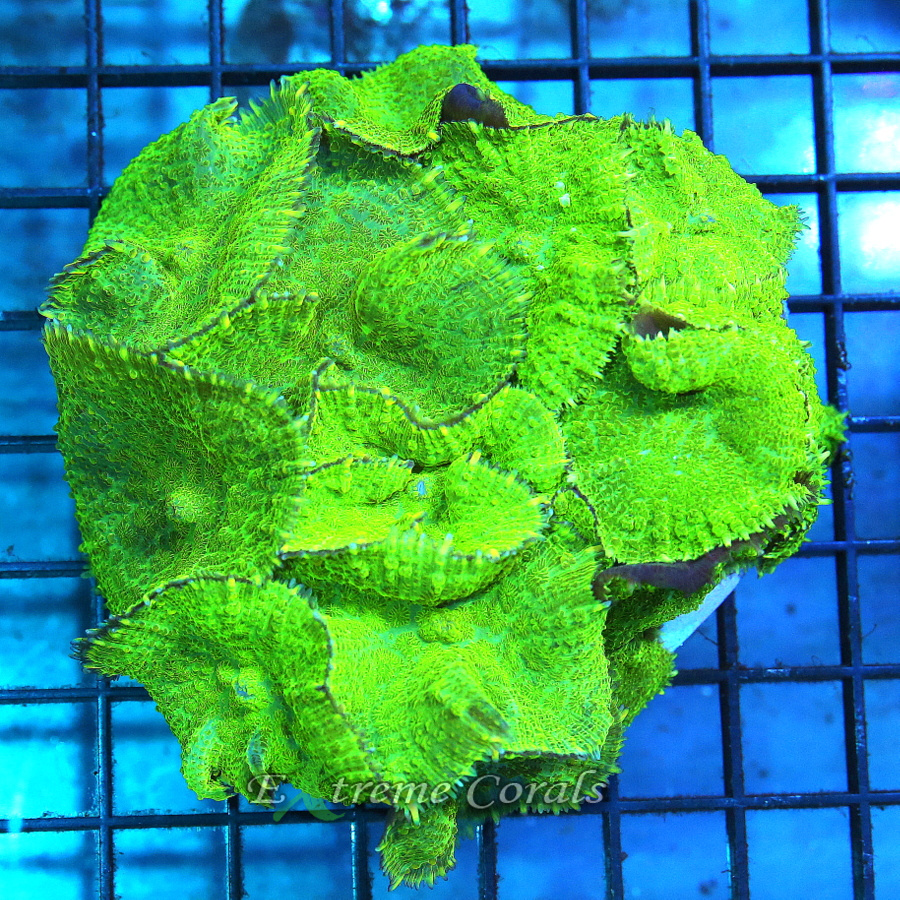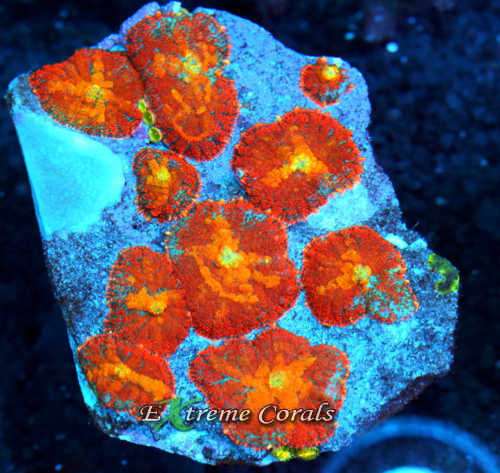Extreme Corals News and Updates
How to Care for Rhodactis Mushrooms in a Reef Tank
Find out how to properly care for your new Rhodactis Mushroom with this "how-to" guide on the requirements for healthy Rhodactis Mushroom from the #1 place to buy corals online!
Read along to find out the Lighting, Water Flow, Feeding, Placement & more when it comes to the care of your new Rhodactis Mushroom
by scott Shiles • March 01, 2023
Rhodactis mushrooms, also known as mushroom corals, are highly sought after in the aquarium hobby due to their stunning
colors and ease of care. These soft corals display a vibrant array of hues including blue, green, orange, and red,
making them a delightful addition to any reef tank. Rhodactis mushrooms thrive in a variety of lighting conditions, and
they are particularly well-suited for tanks with low to moderate lighting levels. This adaptability allows hobbyists
with different lighting setups to enjoy the beauty of these corals.

Water Flow
When it comes to water flow, Rhodactis mushrooms prefer a moderate level. This allows them to efficiently feed on
dissolved nutrients present in the water. However, it is important to avoid high water flow as it can potentially damage
the delicate tissue of the mushrooms. By maintaining a suitable water flow, reef enthusiasts can ensure the optimal
health and well-being of their mushroom corals.
Placement
In terms of placement, Rhodactis mushrooms can be positioned directly on the substrate or attached to a rock or frag
plug. It is crucial to provide enough space between the mushrooms and other corals, as they possess sweeper tentacles
that can sting neighboring corals. This consideration helps prevent any unwanted interactions and promotes a harmonious
environment within the reef tank.
Lighting Requirements
Rhodactis mushrooms, like other mushroom corals, do not require intense lighting to thrive. They can adapt well to low
to moderate lighting conditions. It is important to maintain consistent lighting to prevent any sudden changes in light
intensity that may cause stress to the mushroom coral. Such stress can lead to the mushroom shrinking or detaching from
its substrate.
Light intensity of 75-150 par is generally considered low to moderate lighting, which can be suitable for Rhodactis
mushroom corals. It is also observed that different species within the Rhodactis genus may have varying lighting
preferences. For instance, some rhodactis species have been known to flourish under lower lighting conditions, while
others, like discosoma, may require lighting closer to 150 par for optimal growth.
Overall, Rhodactis mushroom corals exhibit adaptability to a range of lighting conditions. As an aquarist, it is
recommended to provide consistent lighting within the low to moderate range and monitor the specific needs of the
mushroom coral species in question. By maintaining stable lighting conditions, you can promote the healthy growth and
well-being of your Rhodactis mushroom corals.
Nutritional Needs
Rhodactis mushrooms, like other mushroom corals, have an interesting way of obtaining nutrients. They are photosynthetic
organisms, which means they can harness energy from light through the process of photosynthesis. This process allows
them to convert sunlight into usable energy, which contributes to their nutritional needs. However, relying solely on
photosynthesis is not enough for these mushrooms to thrive.
In addition to their photosynthetic abilities, Rhodactis mushrooms require supplementary feeding to meet their
nutritional requirements. They have the remarkable ability to feed on dissolved organic matter, phytoplankton, and
zooplankton present in the water column. This means that they can extract nutrients from their environment by filtering
out particles and organic matter in the water.
To ensure their optimal growth and health, it is recommended to feed these mushrooms 1-2 times a week. The frequency of
feeding can vary depending on the size of the mushroom and its feeding response. By providing these additional feedings,
we can ensure that the mushrooms receive a well-rounded diet and have access to the necessary nutrients for their
overall well-being.
Temperature and Water Parameters
Maintaining stable water parameters is crucial for the health and well-being of Rhodactis mushrooms. These corals thrive
in water temperatures ranging from 72°F to 78°F (22°C to 26°C). Fluctuations outside of this range can stress the corals
and compromise their immune systems, making them more susceptible to diseases and other health issues.
In addition to temperature, it's essential to monitor other water parameters such as pH, salinity, and alkalinity. The
ideal pH range for reef aquariums, including those housing Rhodactis mushrooms, is between 8.1 and 8.4. Salinity should
be maintained at around 1.025 specific gravity, and alkalinity levels should fall within the range of 7-12 dKH (degrees
of carbonate hardness). Regular water testing and adjustments are necessary to ensure these parameters remain stable.
Tankmates and Compatibility
When choosing tankmates for a reef aquarium containing Rhodactis mushrooms, it's essential to consider their
compatibility with other inhabitants. While Rhodactis mushrooms are generally peaceful, they can exhibit aggressive
behavior towards other corals if they feel crowded or threatened. Therefore, it's best to provide ample space between
Rhodactis mushrooms and other corals to prevent any territorial disputes.
Fish and invertebrates that are known to be reef-safe and non-aggressive are typically suitable companions for Rhodactis
mushrooms. However, aggressive or predatory species should be avoided as they may pose a threat to the well-being of the
mushrooms and other tank inhabitants.
Handling and Fragging
When handling Rhodactis mushrooms or performing fragging (fragmentation), it's crucial to take proper precautions to
avoid causing harm to the corals. These mushrooms have delicate tissues that can easily tear or become damaged if
mishandled.
When moving or fragging Rhodactis mushrooms, it's advisable to use soft, non-abrasive tools such as coral propagation
forceps or plastic bone cutters. Care should be taken to minimize stress to the corals during the process, and any cuts
or tears should be kept clean to prevent infection.
After fragging Rhodactis mushrooms, it's essential to provide proper care and monitoring to ensure the newly separated
fragments establish themselves successfully. This includes maintaining stable water parameters, providing adequate
lighting and water flow, and monitoring for signs of stress or infection in the newly fragged pieces.
Disease Prevention and Treatment
While Rhodactis mushrooms are relatively hardy and resistant to many common coral diseases, they are still susceptible
to certain health issues if proper care is not taken. To prevent diseases such as coral bleaching, tissue necrosis, or
infections, it's essential to maintain optimal water quality and provide a suitable environment for the corals to
thrive.
Regular observation of the mushrooms for any signs of distress or disease is also crucial for early detection and
treatment. If any abnormalities are observed, such as changes in color, tissue recession, or unusual behavior, prompt
action should be taken to identify and address the underlying cause.
Quarantining new additions to the aquarium and practicing good hygiene and maintenance procedures can also help prevent
the introduction and spread of diseases within the reef tank. If necessary, various treatments and interventions, such
as dips or medications, may be employed to combat specific health issues affecting Rhodactis mushrooms.
overall rating:
my rating:
log in to rate
Please log in to leave a comment.
For more information visit: additional resources

